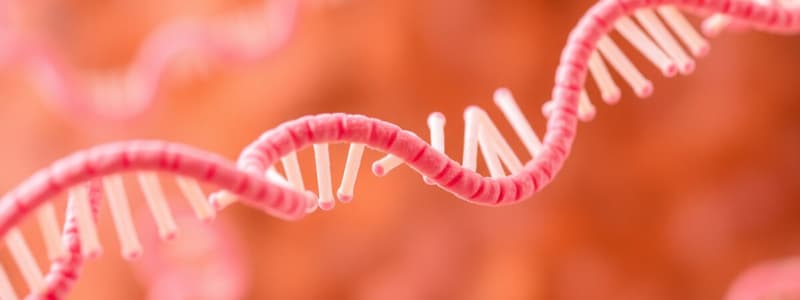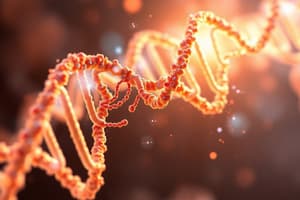Podcast
Questions and Answers
What is the purpose of the start codon AUG in protein synthesis?
What is the purpose of the start codon AUG in protein synthesis?
- It codes for Glycine
- It initiates the translation of all proteins
- It terminates protein synthesis
- It codes for Methionine (correct)
The genetic code is nonoverlapping, meaning that codons overlap with one another.
The genetic code is nonoverlapping, meaning that codons overlap with one another.
False (B)
How many codons are responsible for terminating protein synthesis?
How many codons are responsible for terminating protein synthesis?
3
In eukaryotic ribosomes, the two subunits are ____ and ____.
In eukaryotic ribosomes, the two subunits are ____ and ____.
Match the components required for protein synthesis with their roles:
Match the components required for protein synthesis with their roles:
Which of the following codons are termination codons recognized by releasing factors?
Which of the following codons are termination codons recognized by releasing factors?
Antibiotics can only affect eukaryotic ribosomes due to their size.
Antibiotics can only affect eukaryotic ribosomes due to their size.
What is the function of releasing factors in protein synthesis?
What is the function of releasing factors in protein synthesis?
The structure that consists of one mRNA and multiple ribosomes is called a __________.
The structure that consists of one mRNA and multiple ribosomes is called a __________.
Match each antibiotic with its corresponding action:
Match each antibiotic with its corresponding action:
What is the role of the P site in protein synthesis?
What is the role of the P site in protein synthesis?
The A site is responsible for the assembly of components before peptide bond formation.
The A site is responsible for the assembly of components before peptide bond formation.
What is the significance of the initiator tRNA?
What is the significance of the initiator tRNA?
Protein synthesis translates the codons on mRNA into _____ that constitute the protein.
Protein synthesis translates the codons on mRNA into _____ that constitute the protein.
Match the following steps of protein synthesis with their descriptions:
Match the following steps of protein synthesis with their descriptions:
During which step of protein synthesis does peptidyl transferase enzyme act?
During which step of protein synthesis does peptidyl transferase enzyme act?
The ribosomes move three bases toward the 5’ end of mRNA during translocation.
The ribosomes move three bases toward the 5’ end of mRNA during translocation.
What happens during the termination step of protein synthesis?
What happens during the termination step of protein synthesis?
What is released when a new nucleotide is added to the growing RNA chain?
What is released when a new nucleotide is added to the growing RNA chain?
The presence of palindromes in the termination region on DNA is irrelevant for RNA polymerase.
The presence of palindromes in the termination region on DNA is irrelevant for RNA polymerase.
What is the role of the 7-methylguanosine triphosphate in mRNA processing?
What is the role of the 7-methylguanosine triphosphate in mRNA processing?
The process of adding a chain of 40-250 adenine nucleotides to the 3' end of mRNA is known as __________.
The process of adding a chain of 40-250 adenine nucleotides to the 3' end of mRNA is known as __________.
Match the following steps of mRNA post-transcriptional modifications with their descriptions:
Match the following steps of mRNA post-transcriptional modifications with their descriptions:
What is the function of the Rho factor in RNA termination?
What is the function of the Rho factor in RNA termination?
Codons are the sequences of 4 nucleotide bases on mRNA.
Codons are the sequences of 4 nucleotide bases on mRNA.
What is the genetic code?
What is the genetic code?
What is the primary role of mRNA in a cell?
What is the primary role of mRNA in a cell?
Ribosomal RNA (rRNA) makes up 15% of the total RNA in the cell.
Ribosomal RNA (rRNA) makes up 15% of the total RNA in the cell.
What are the three main steps of transcription?
What are the three main steps of transcription?
The ___________ region in prokaryotic cells is recognized by the RNA polymerase during initiation.
The ___________ region in prokaryotic cells is recognized by the RNA polymerase during initiation.
Match the following RNA types with their primary functions:
Match the following RNA types with their primary functions:
Which RNA polymerase in eukaryotic cells is responsible for synthesizing mRNA?
Which RNA polymerase in eukaryotic cells is responsible for synthesizing mRNA?
All types of RNA in prokaryotes are synthesized by multiple RNA polymerases.
All types of RNA in prokaryotes are synthesized by multiple RNA polymerases.
How many base pairs are found between the Pribnow box and the second nucleotide sequence in prokaryotic promoters?
How many base pairs are found between the Pribnow box and the second nucleotide sequence in prokaryotic promoters?
The building blocks of RNA are ribonucleotides, which consist of a nitrogenous base, sugar __________, and phosphate.
The building blocks of RNA are ribonucleotides, which consist of a nitrogenous base, sugar __________, and phosphate.
Which of the following statements regarding the anticodon region of tRNA is correct?
Which of the following statements regarding the anticodon region of tRNA is correct?
Flashcards
Specificity of Genetic Code
Specificity of Genetic Code
A specific codon always codes for only one amino acid.
Degeneracy of Genetic Code
Degeneracy of Genetic Code
Multiple codons can code for the same amino acid.
Non-overlapping Genetic Code
Non-overlapping Genetic Code
The genetic code is read continuously from a fixed starting point, three bases at a time.
Universality of Genetic Code
Universality of Genetic Code
Signup and view all the flashcards
Translation (Protein Synthesis)
Translation (Protein Synthesis)
Signup and view all the flashcards
Stop codons
Stop codons
Signup and view all the flashcards
Releasing factors
Releasing factors
Signup and view all the flashcards
Polysome
Polysome
Signup and view all the flashcards
Antibiotics
Antibiotics
Signup and view all the flashcards
Diphtheria toxin
Diphtheria toxin
Signup and view all the flashcards
Codon
Codon
Signup and view all the flashcards
Termination Region
Termination Region
Signup and view all the flashcards
Palindrome
Palindrome
Signup and view all the flashcards
Rho Factor
Rho Factor
Signup and view all the flashcards
mRNA Post-Transcriptional Modifications
mRNA Post-Transcriptional Modifications
Signup and view all the flashcards
5' Cap
5' Cap
Signup and view all the flashcards
Poly-A Tail
Poly-A Tail
Signup and view all the flashcards
Introns
Introns
Signup and view all the flashcards
Transcription
Transcription
Signup and view all the flashcards
Translation
Translation
Signup and view all the flashcards
Messenger RNA (mRNA)
Messenger RNA (mRNA)
Signup and view all the flashcards
Transfer RNA (tRNA)
Transfer RNA (tRNA)
Signup and view all the flashcards
Ribosomal RNA (rRNA)
Ribosomal RNA (rRNA)
Signup and view all the flashcards
Promoter Region
Promoter Region
Signup and view all the flashcards
Termination Unit
Termination Unit
Signup and view all the flashcards
RNA polymerase
RNA polymerase
Signup and view all the flashcards
Initiation (Transcription)
Initiation (Transcription)
Signup and view all the flashcards
Elongation (Transcription)
Elongation (Transcription)
Signup and view all the flashcards
What are the three sites on a ribosome?
What are the three sites on a ribosome?
Signup and view all the flashcards
What is protein synthesis?
What is protein synthesis?
Signup and view all the flashcards
What happens during the initiation phase of protein synthesis?
What happens during the initiation phase of protein synthesis?
Signup and view all the flashcards
What happens during the elongation phase of protein synthesis?
What happens during the elongation phase of protein synthesis?
Signup and view all the flashcards
How does the ribosome move during elongation?
How does the ribosome move during elongation?
Signup and view all the flashcards
What happens during the termination phase of protein synthesis?
What happens during the termination phase of protein synthesis?
Signup and view all the flashcards
Why is protein synthesis important?
Why is protein synthesis important?
Signup and view all the flashcards
What is peptidyl transferase?
What is peptidyl transferase?
Signup and view all the flashcards
Study Notes
Nucleic Acids II
- Nucleic acids are single-stranded polynucleotides.
- The central dogma describes the flow of genetic information from DNA to RNA to protein.
- DNA is the master plan, containing the genetic information of an organism.
- mRNA is the working copy of DNA, expressing the master plan.
- Transcription is the process of copying DNA to create mRNA.
- Translation is the process of converting mRNA into protein.
- RNA types include mRNA, tRNA, rRNA, and small RNA molecules.
- mRNA carries genetic information from DNA to the cytoplasm for protein synthesis.
- mRNA makes up about 5% of the total RNA in a cell.
- Each three consecutive nucleotides in mRNA form a codon, which codes for a specific amino acid.
- tRNA is an adaptor molecule carrying amino acids.
- tRNA makes up about 15% of the total RNA.
- tRNA has three loops and two free ends.
- tRNA has an anticodon region that is complementary to codons on mRNA.
- rRNA is found in association with proteins in ribosomes, serving as sites for protein synthesis.
- rRNA makes up about 80% of the total RNA.
- Prokaryotic ribosomes are 70S with subunits 50S and 30S.
- Eukaryotic ribosomes are 80S with subunits 60S and 40S, differences in ribosomal subunit composition.
- RNA consists of a nucleotide compound with nitrogenous bases, a ribose sugar, and a phosphate group.
- RNA's nucleotides are linked by phosphodiester bonds.
- RNA exists as single strands capable of complex folding.
- The most common nitrogenous bases in RNA include adenine, guanine, cytosine, and uracil (instead of thymine).
RNA Structure
- RNA is a polynucleotide, building blocks of nucleotides.
- A nucleotide is composed of a nitrogenous base, ribose sugar, and monophosphate.
- Nucleotides are connected via phosphodiester bonds.
- RNA exists as single strands that can fold into complex structures.
Messenger RNA (mRNA)
- mRNA is the working copy of the DNA.
- It carries genetic information from DNA to the cytosol for protein synthesis.
- It comprises about 5% of total RNA.
- mRNA codons specify particular amino acids.
Transfer RNA (tRNA)
- tRNA is a molecule that carries amino acids.
- tRNA comprises about 15% of total RNA in a cell.
- tRNA has three loops and two free ends and an anticodon.
- tRNA's anticodon sequence matches corresponding mRNA codons.
Ribosomal RNA (rRNA)
- rRNA is found in ribosomes and is essential for protein synthesis.
- rRNA makes up the majority (about 80%) of total RNA in a cell.
- Prokaryotic rRNA has three types (5S, 23S, and 16S)
- Eukaryotic rRNA has four types (5S, 5.8S, 28S, and 18S)
- S refers to Svedberg units, a measure of sedimentation rate.
RNA Transcription
- mRNA synthesis is known as RNA transcription.
- Transcription requires a DNA template, ribonucleotides (phosphates A, G, C, U) and RNA polymerase.
- DNA template consists of a promoter region, a transcription unit, and a termination unit.
- Promoter region initiates transcription.
- Transcription unit is the transcribed region.
- Termination unit ends transcription.
Promoter Region
- Prokaryotic promoters have a Pribnow box (-10 region) and a -35 region.
- Eukaryotic promoters have a TATA box and a CAAT box.
Prokaryotic RNA Polymerase
- One type of RNA polymerase synthesizes all types of RNA molecules.
- RNA polymerase enzyme responsible for synthesis of RNA molecules.
Eukaryotic RNA Polymerases
- Eukaryotes have three types of RNA polymerases: I, II, and III.
- RNA polymerase I synthesizes rRNA.
- RNA polymerase II synthesizes mRNA and has a promoter region.
- RNA polymerase III synthesizes tRNA and small RNA.
Steps of Transcription
- Initiation, elongation, and termination.
Steps of protein synthesis
- Initiation, elongation, and termination.
Initiation
- Ribosomes, mRNA, aminoacyl-tRNA specified by the first codon (AUG for methionine), and initiation factors are involved.
- The initiator tRNA (carrying methionine) enters the P site. First codon recognized by a special initiator tRNA.
Elongation
- Amino acids are added to the growing polypeptide chain.
- The aminoacyl-tRNA whose codon appears next on mRNA will be delivered to the A-site.
- The carboxyl group of aminoacyl-tRNA in the P site is transferred to the amino group of the new aminoacyl-tRNA in the A site.
- Ribosomes move three bases along the mRNA.
- The uncharged tRNA leaves the ribosome.
Termination
- The ribosome reaches a termination codon (UAA, UAG, or UGA).
- Release factors recognize termination codons.
- The bond between peptide and tRNA is hydrolyzed.
- The polypeptide is released.
- Ribosome subunits dissociate.
Polysomes
- Multiple ribosomes can translate the same mRNA simultaneously.
- This complex of mRNA and ribosomes is called a polysome.
Inhibition of Protein Synthesis
- Antibiotics target bacterial ribosomes (70S), which are different from eukaryotic ribosomes (80S).
Studying That Suits You
Use AI to generate personalized quizzes and flashcards to suit your learning preferences.




